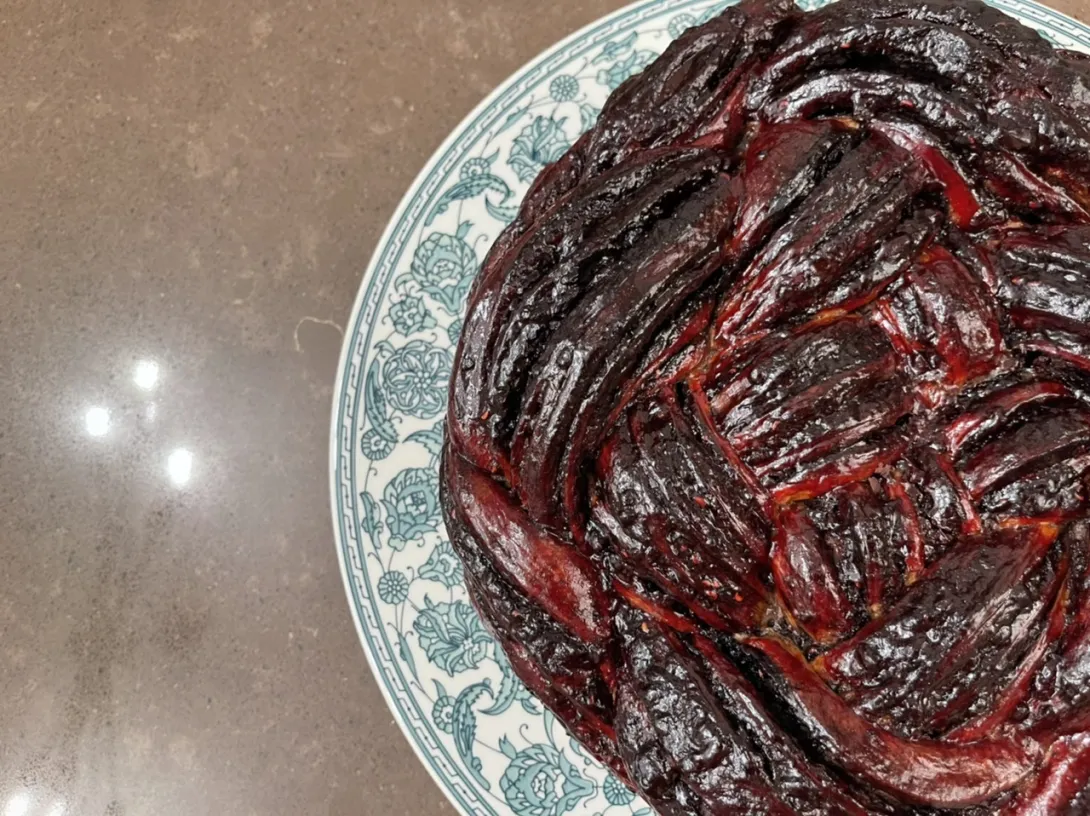
I have previously made babkas with limited success. My first ones had much too wet a filling and didn’t bake long enough so collapsed in the center. My last babka we pretty successful and delicious, it was the Matcha black sesame wreath babka with yuzu glaze. Now I love chocolate and hadn’t tried to make a chocolate one. So this time around I thought I’d add a twist and make it raspberry chocolate. I needed more jam anyways so decided I’m make a homemade raspberry jam, not having any pectin I thought I’d use the pectin in lemon juice to thicken the jam and also ensure a bit of extra tartness. Despite that, I found the jam a bit too sweet so next will will use less sugar than fruit by weight to reduce the sweetness. Regardless the jam turned out well and was perfect with the chocolate to fill the babka.
This babka recipe is by Maurizio Leo I’ve made few changes to it except that I added a small pinch of IDY because this dough can be very very slow to ferment and I didn’t want the dough to be too sour if it took that long to proof.
I did not do an overnight cold retard instead retarding only for about 1.5 hours to make the dough cooler for ease of rolling.
Vitals
Total Dough Weight | 800 grams |
Pre-fermented Flour | 13.00% |
Yield | One babka for a 9″ x 4″ x 4″ Pullman pan (without lid) or 9” cake pan for four strand braid. |
Total Formula
Weight | Ingredient | Baker’s Percentage |
357g | All-purpose flour (11-12% protein; King Arthur All-Purpose Flour) | 100.00% |
107g | Whole milk (cold from the fridge) | 30.00% |
107g | Large eggs (about 2, cold from the fridge, plus one more egg in reserve for the egg wash) | 30.00% |
100g | Unsalted butter (Kerrygold; room temperature) | 28.00% |
46g | Water | 13.00% |
29g | Caster sugar (superfine white sugar) | 8.00% |
8g | Salt | 2.30% |
46g | Sourdough starter (100% hydration) | 13.00 |
Dough Mix
My final dough temperature for this dough was 76°F (24°C).
Weight | Ingredient |
310 g | All-purpose flour (11-12% protein; King Arthur All-Purpose Flour) |
107 g | Whole milk (cold from the fridge) |
107 g | Large eggs (about 2; cold from the fridge) |
100 g | Unsalted butter (Kerrygold; room temperature) |
29 g | Caster sugar (superfine white sugar) |
8 g | Salt |
138 g | Mature, but mild, levain |
2. Mix
Before mixing, take out the butter called for in the recipe and cut it into 1/2″ pats. Let it sit at room temperature until called for.
I used my KitchenAid stand mixer to mix this dough. To the bowl of a stand mixer fitted with the dough hook attachment, add the mature levain, flour, whole milk, large eggs, salt, and half of the sugar. Set the mixer to low and mix until everything is incorporated. Let the dough rest, uncovered, for 10 minutes.
After the 10 minute rest, turn the mixer up to medium and mix for 5 minutes until the dough starts to pull from the sides of the mixing bowl. At this point, slowly stream in the remaining sugar while the mixer is running. Mix for another 1-2 minutes until the dough comes back together.
With the mixer still set to medium, add the room temperature butter, one pat at a time, waiting to add the next until the previous is absorbed into the dough. It might take around 5 minutes to mix all the butter into the dough. After all of the butter is added, continue mixing for another few minutes until the dough smooths out and once again begins to cling to the dough hook. The dough should be almost fully developed at this point (it won’t completely pass the windowpane test, but almost).
Transfer the dough to a container for bulk fermentation, cover, and keep somewhere warm—78-80°F (26-27°C)—in your kitchen for bulk fermentation.
3. Warm Bulk Fermentation – 2 hours. (or longer, as needed)
During this time, give the dough 2 sets of stretch and folds where the first set is 30 minutes after the beginning of bulk fermentation and the second set is 30 minutes after the first. After the second set, let the dough rest, covered, until the next step.
4. Cold Bulk Fermentation – (next day)
Assess the dough: has it risen a little in the bowl during the warm bulk fermentation? It should be a little puffy and smoothed out. If it looks like there’s no activity at all, give the dough another 30 minutes to 1 hour and check again.
Once you see some rise in the dough, place the covered bulk fermentation bowl into the refrigerator overnight.
Same day option:
I much prefer making this over the course of two days, but you could make this all in one day: let the dough finish bulk fermentation for 2-3 hours on the counter. When the dough has risen around 50% and feels puffy, proceed with the rest of the steps below. However, I do recommend placing the dough in the fridge for at least 1 hour after this warm bulk fermentation to chill before rolling out!
5. Roll, freeze, cut, and shape
Before taking the dough out of the refrigerator, make the fillings, if making jam prepare a day ahead to allow it to cool.
Divide the dough into two, shape tightly into balls.
On a lightly floured surface roll one dough ball into large rectangle 16” x 12”, first spread half of the jam, cocoa, butter mixture on, then sprinkle half of the chopped chocolate sugar mixture. Roll into a tight roll then transfer onto a cookie tray. Repeat for the other dough.
Important:
Place the rolled-up log on a baking sheet and place it into the freezer for 15 minutes (this makes it much easier to cut and braid).
After the 15-minute freezer rest, take the baking sheet out of the freezer and return the dough log to the counter. Using a sharp knife, cut the log to split open the log from one side to the other. Pinch the two top halves together and braid the dough one strand over the other. At the bottom, pinch the two halves together again. Don’t worry if filling spills out or things get messy — it’s all good.
After the dough is braided, pick up the braid and place it on the parchment right in the middle, then pick up the sides of the parchment and lift the dough up and drop it into the pan.
Cover the pan and place it somewhere warm, ideally, 78-80°F (26-27°C), to proof.
6. Proof
This dough can be slow to rise at this point. Give it the time it needs to rise up to about 1/2″ below the rim of the Pullman pan. For me, at 78°F (26°C), it took about 3.5 hours. See the image below for how high my dough filled my pan.
7. Bake
Preheat your oven with the rack in the middle to 350°F (176°C) — no fan assist (no convection). When the oven is preheated and the babka dough is fully proofed, place the pan on a baking sheet lined with parchment paper (to catch any sugar spilling over). In a small bowl, whisk together one whole egg and 1 Tbsp water and brush a thin layer of the egg wash on the top of the dough. Then, slide the baking sheet into the oven and bake for 55 minutes until the center of the babka reaches 200°F (93°C) then leave in oven with the oven off for another 5 mins.. Keep an eye on the babka in the last 10 minutes of the bake, if it’s coloring too quickly drop the temperature to compensate.
Once out of the oven brush a layer of the raspberry syrup on the babka.
Raspberry Jam
400 g frozen raspberries
425 g sugar (should reduce a bit more still very sweet)
½ lemon juice
Mash together raspberries and sugar in a saucepan on medium heat. On sugar dissolved add juice of ½ lemon. Gradually bring to a boil. The jam should reach 221ºF for the pectin in the lemon juice to thicken the jam if not using jam sugar.
For the Filling
- 3/16 cup raspberry jam
- 1 tbsp. cocoa powder
- 1 tbsp. unsalted butter, at room temperature
- 4 oz. 113.4 g bittersweet chocolate, finely chopped
- ⅛ cup sugar
Syrup
- 1⁄8 cup sugar
- ½ cup fresh raspberries, mashed
- 1 tbsp water
Make the filling:
Combine jam and cocoa powder in a small bowl; using your fingers, add butter until moist and crumbly and set jam mixture aside. Combine chocolate and 1⁄8 cup sugar in a bowl; set chocolate mixture aside.
The jam mixture is the first to be spread on the rolled out dough, then the chocolate sugar mixture is sprinkled on top.
Make the syrup:
Combine raspberries, remaining 1⁄8 cup sugar, and 1 tbsp. water in a 2-qt. saucepan over high; reduce heat and simmer until sugar has dissolved, 1–2 minutes. Remove from heat and let stand 10 minutes; strain through a fine mesh sieve, discarding solids
- Benito's Blog
- Log in or register to post comments
Here are a couple of photos of the start and end of the plaiting.
Oh I love the raspberry syrup on this, what a lovely deep red hue.
Raspberry 😍 syrup. Oh my. I might have to give that some thought.
Beautiful plaiting!
Did the IDY make for a less dense outcome? I also found that Maurizio's enriched dough took some time to get going last time.
Jon
Jon, I’m not sure that the IDY changed the crumb, but it was quicker to get going again after the freezer chilled the rolls.
Delicious if I say so myself. It is sweet but not excessively so, I really don’t like things that are too sweet. I love the balance of the raspberry and chocolate.
Image
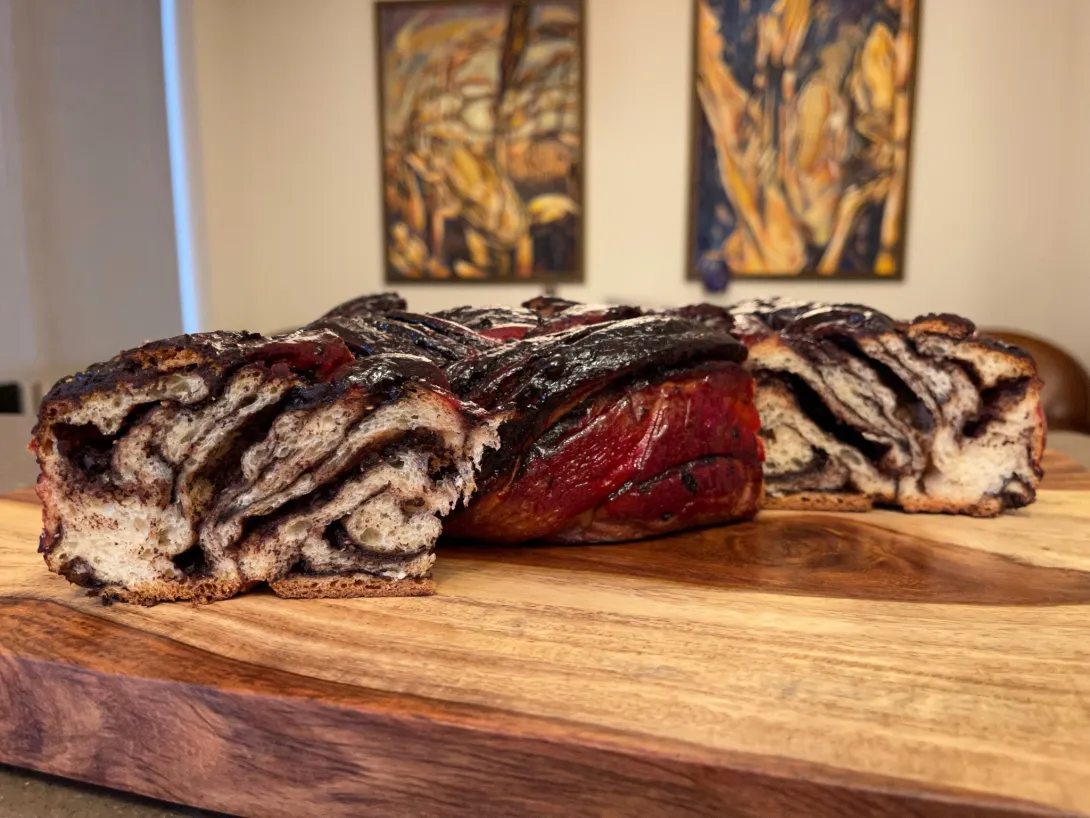
Image
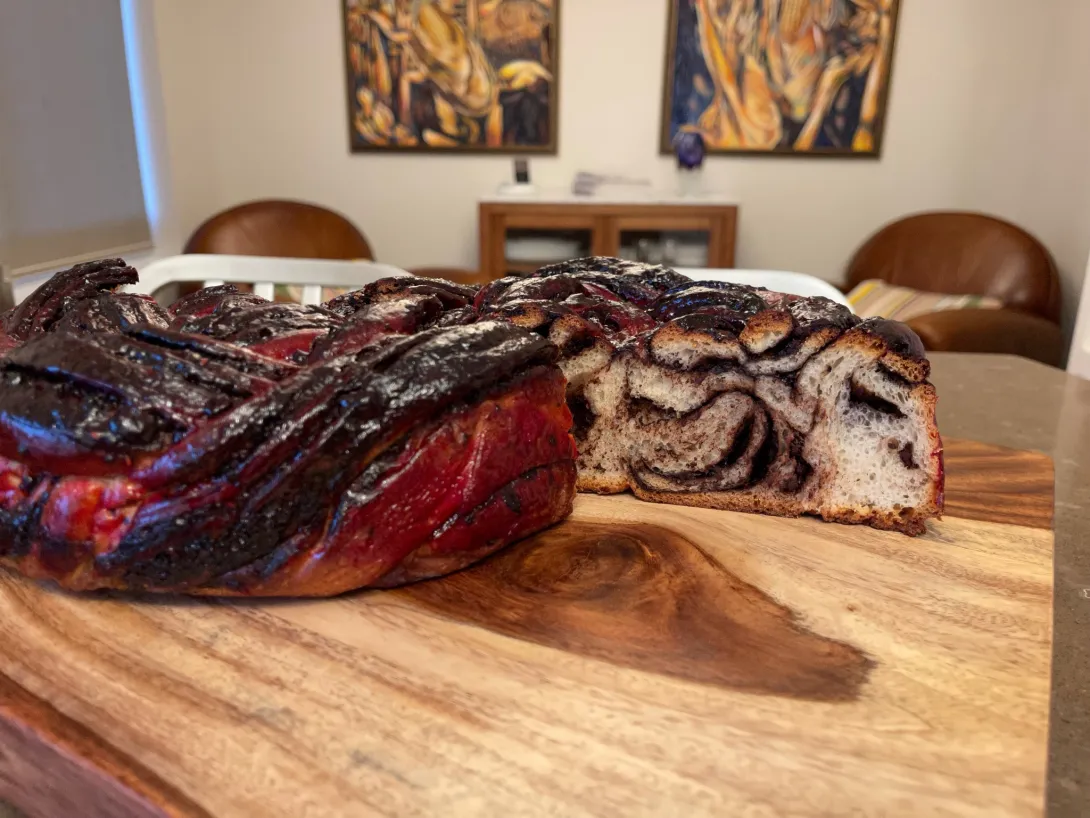
Image
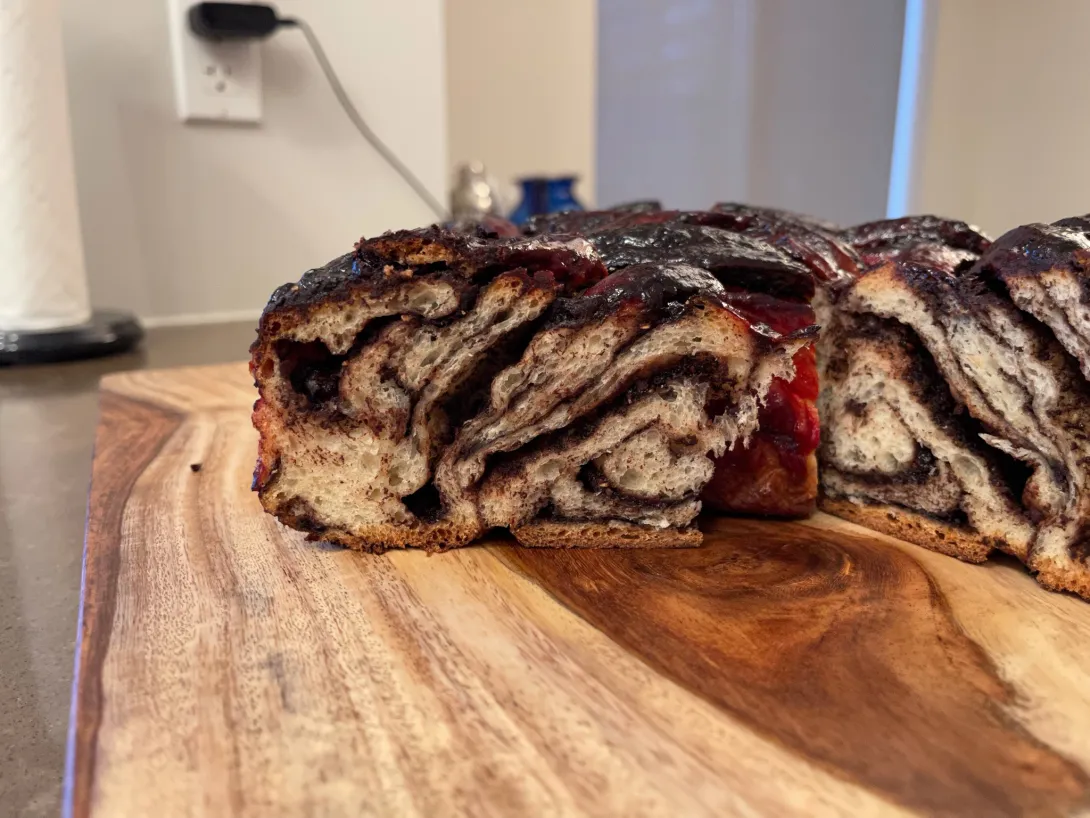
Hi Benny,
Thanks for the detailed write up.
I've plugged your recipe into the spreadsheet I created for this bake and I came to the following final numbers (rounded for convenience):
Is that what you have, too?
The big difference I notice is hydration. I have seen some quite high hydration examples but my own ended up around 49% and my calculations show Danny's reference at ~40%.
Does that accord with your calculations? If so, was the higher than normal hydration to deal with using a starter rather than commercial yeast - to give it a less stressful time and further tame any potential sour flavours?
The other difference is the salt. These numbers seemed to vary wildly between recipes with one I saw having somewhere near 3%! My own ended up around 0.8% and the reference was very low at ~0.25%. What's the reasoning behind such a high number for the sweet bread? (Especially given you altered the base recipe to rise faster.)
Thanks,
dan.
Hi Dan, I calculate the hydration at about 70% so very close to your calculation. Now this recipe isn’t my own, this is based on Maurizio’s but adding a small pinch of IDY. Based on past experience I knew this dough would ferment slowly, so wanting to do a same day bake I added that pinch of IDY. I wonder if the lower hydration in some other recipes contributes to the denser crumb I know some people comment on? This dough was nice to work with, it was nicely extensible so I was able to roll it out pretty broadly and thus able to get a good roll with enough layers to it. The higher hydration likely helped with extensibility along with a lower protein flour.
2% salt is pretty standard for most breads so I’m surprised that some babka recipes call for either so little or so much. My only bread I’ve baked with a high 3% of salt was my recent Danish rye. I thought that the salt was so high because of the high percentage of seeds in it and if you treated the seed weigh as flour then the salt was 2%. However, after fully cured I found that the bread was a bit too salty for my tastes and I would bake it at 2% in the future. I wonder if some recipes reduce the salt to help the yeast deal with the sugar and other enrichments, salt slowing them so less being helpful? I cannot think of a good reason for ever using more than 2% salt in bread.
Benny
Hmm, yes, I did notice a bit of pull-back on my dough when rolling out, though our Australian flour is somewhat weaker than yours, with plain ('AP') usually sitting between 10-11% so I would think it might balance out in the end, though I also used a little less fat (23% vs 26%) than yours.
I did notice that my crumb wasn't super loose and tearable - certainly less 'flaky' than yours but, again, I like a little dense.
On the salt, The first few recipes the almighty Google algorithms assume I want to see show 1tsp of salt to about 500-550gm of flour, so about 1 - 1.2%.
Interesting, I never gave the salt % any thought, going with less would certainly help speed up fermentation which is beneficial with these enriched breads especially if you are using your starter rather than IDY. But even IDY if you don’t have osmotolerant yeast can use the help. I’m also thinking that cakes and other sweets don’t use anywhere near 2% salt so perhaps for sweet breads like this it is customary to reduce the salt?
The lack of osmotolerant yeast was part of my own calculations and was one reason I went a little higher than I otherwise might have (1.7% IDY) and also why I made a sponge first (~1hr) - just to kick it along so it had time to work without competition.
That said, most cakes aren't yeast-raised so the salt doesn't have any effect of raising power there.
Where I have seen ~2% salt is with 'propper' brioche, though perhaps that is there to help strengthen the dough, given the heart-stopping amounts of butter.
d.
Yes, that wasn’t my point about the cakes, of course most aren’t yeasted, just seems that for most sweet applications the salt is pretty low, that’s all.
(Expanded from the community bake post.)
Many recipes I see are 1:1 but plenty are at 2:1 or even 3:1, favouring the fruit. I don't think I've ever actually seen a (fruit) jam recipe with more sugar than fruit - even for comparatively tart and acidic fruit like raspberries. (Some jams with sweeter fruit I've seen go as far as 4:1!)
I think that, in the case of raspberries, which are naturally a little acidic, I wouldn't have thought you would have needed quite so much lemon either to get it to set.
As 1/2 lemon is convenient, I would think upping the raspberries to 500g would be good - certainly what I would do as ours tend to come in 500gm packets - and then dropping the sugar accordingly, so 325gm. (I would probably go down to 300gm for neatness.)
One note on your description - lemon juice (like most fruit juices) doesn't actually contain much pectin at all so in your jam nearly all the pectin is coming from the raspberries. What the lemon juice does is provide acidity, which the pectin needs to do its thing. (Most pectin is in the skin/rind so, although lemons are, overall, high in pectin, the juice alone isn't.)
d.
Well that is interesting regarding the lemon juice. I had read somewhere on the net, but you can’t believe everything you read on the net, that if you don’t have pectin or jamming sugar to add lemon juice for the pectin. Yes I agree, for 500 g of raspberries only 300 g of sugar is probably more than enough for future jams. Other than raspberry jam I’ve never made jam so have never researched it to see what other recipes look like, so thanks Dan.
Benny
Most fruits and vegetables have pectin - they just vary in amount. Most of the pectin in any fruit is in the skin and, if relevant, the core (e.g. apples) so you'll get the most pectin from fruits that are kept whole - berries being an excelletn example. Not all berries are high in pectin - even kept whole - but the consensus appears to be that raspberries are higher than most.
Jam's actually rather a lot like bread in several ways - not only is it a similar balacing act between just a few ingredients (pectin, sugar and acid and water,) it's also a broadly analagous process of trying to activate the natural strands (gluten or pectin) through the tuning of those ingredients, accounting for the natural variations in the core ingredient (flour/fruit).
Oh I should add despite the raspberry jam eaten on toast being a bit too sweet for my liking, the babka wasn’t at all too sweet.
Benny
I did notice your sugar level was lower than others I see - at about 7.5% (baker's %) vs 17% for the reference recipe. (My own was a touch lower at 16%, though my filling was less sweet and more bitter than the Nutella that seems so common.)
All up, everything points to a really finely-tuned balance on your part!
Thank you Dan for all your comments, you are such a knowledgeable baker, what is your background?
Professionally, I'm in IT, which I suppose attracts those of us with a deep need to understand everything - how parts form the whole and how changing one step changes the result. I don't just want to know that an autolyse makes a dough more extensible; I need to know why it does. I'm not even content to find that it 'weakens the gluten'; I want to understand how.
Personally, however, I am simply a lover of bread. Potentially, that has something to do with a French and Italian heritage and the fixtures of baskets of crusty rolls (bought by the literal sackful) at every family meal and the constant output of choux and pane au chocolat from my grandfather.
Creatively, I love the tinkering and the experimenting and the sheer joy that comes from going by 'feel', knowing that, what you have made is unique. While I nearly always use recipes, they are nearly always of my own creation and often end up scribled over with on-the-fly adjustments, and substitutions. With the exception of a plain shortbread I made - as a control - to take to work, I can't remember the last time I followed a printed recipe.
So far as baking goes, I have been at it, on-and-off, for 5 or so years, following the 'why not?' decision to try to create a sourdough starter. The lack of any good fresh bread close to me is an increasing motivation.
I too like to know the whys, but it seems sometimes the whys aren’t out there yet. Anyhow, I appreciate your obvious great knowledge of baking.
Benny
Be happy just baking great bread - else you may end up like me, reading sentences like this at 2 in the morning:
. . . and images like this:
Image
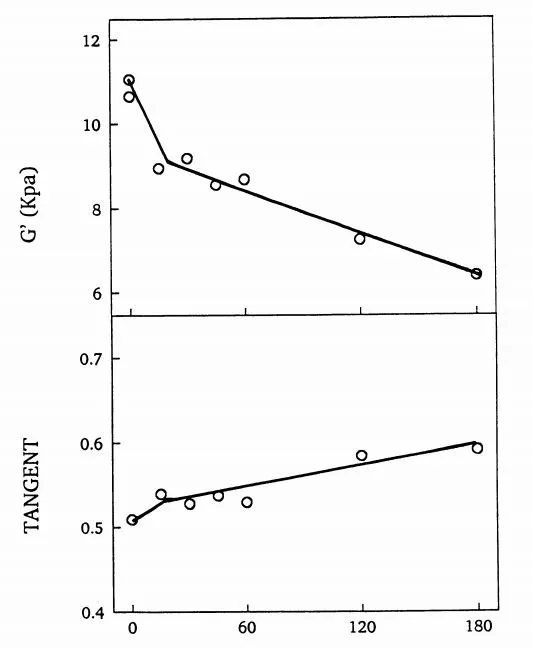
(Give-or-take, this shows the effects of an autolyse - you can see relatively clearly why 15 mins is sufficient for most purposes for basic doughs!)
d.
Wow! You have convinced me to give this a try soon. I usually leave the sweet baking to my wife but I’m loving the raspberry and chocolate filling idea.
Best,
Ian
That’s great Ian, I do hope you give it a try. My partner said he couldn’t taste the raspberry enough, I’ve adjusted the raspberry jam up by another 50% which is reflected in the recipe above. I hope you like it but let me know either way.
Benny
when you did but with mixed dark berries. Did a 1:1 sugar soak and wondered if it was dcadent enough without chocolate.
Well you certainly answered that one! Wow! Love that deep red glow on top and around the chocolate marbling.
Oh my goodness, yes! Wedges!
(Is there matcha in this babka too? I think it's a typo, not listed as an ingredient, just mentioned in the directions.)
Yes I love that red hue that the raspberry syrup gives the babka and it makes it nice and shiny as well. Sorry about the editing error, I thought I had removed all traces of the matcha black sesame from the recipe but obviously hadn’t. Thanks for picking that up, there is no matcha in this dough so I have edited it out. Hopefully there are no other errors.
I hope you’re making a babka with that jam Mini, I’d love to see a Mini baked babka!
Benny
Any leftover for me please? 😉
Thank you Christi, yes there is some left over that I’ve frozen. We will be bringing this to visit our friends in PEC later today.
Benny
Benny, you already know, I think, how much I love babka, and this babka of yours is a must try for me! I would appreciate it if you could give a more detailed explanation of the braiding scheme - for the round cake pan version. Thanks for sharing this amazing creation with us!!
Hi Sturgis, I just googled a video for you, it might be challenging to explain in words what a video would make easier.
This is exactly what I did, except with more chocolate raspberry on the counter and my hands! What I didn’t do the best was to tuck the ends underneath the dough to elevated the center of the babka more to give it a more round shape vertically.
Benny
Excellent! Thanks brother!